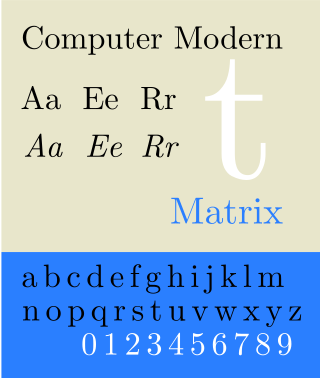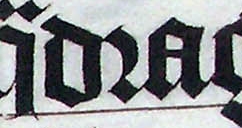
The Cyrillic script, Slavonic script or the Slavic script is a writing system used for various languages across Eurasia. It is the designated national script in various Slavic, Turkic, Mongolic, Uralic, Caucasian and Iranic-speaking countries in Southeastern Europe, Eastern Europe, the Caucasus, Central Asia, North Asia, and East Asia, and used by many other minority languages.
Digamma or wau is an archaic letter of the Greek alphabet. It originally stood for the sound but it has remained in use principally as a Greek numeral for 6. Whereas it was originally called waw or wau, its most common appellation in classical Greek is digamma; as a numeral, it was called episēmon during the Byzantine era and is now known as stigma after the Byzantine ligature combining σ-τ as ϛ.
Epsilon is the fifth letter of the Greek alphabet, corresponding phonetically to a mid front unrounded vowel IPA: [e̞] or IPA: [ɛ̝]. In the system of Greek numerals it also has the value five. It was derived from the Phoenician letter He . Letters that arose from epsilon include the Roman E, Ë and Ɛ, and Cyrillic Е, È, Ё, Є and Э.
Koppa or qoppa is a letter that was used in early forms of the Greek alphabet, derived from Phoenician qoph (𐤒). It was originally used to denote the sound, but dropped out of use as an alphabetic character and replaced by Kappa (Κ). It has remained in use as a numeral symbol (90) in the system of Greek numerals, although with a modified shape. Koppa is the source of Latin Q, as well as the Cyrillic numeral sign of the same name (Koppa).

Fraktur is a calligraphic hand of the Latin alphabet and any of several blackletter typefaces derived from this hand. Letters are designed such that the individual strokes are broken apart; in this way it is often contrasted with the curves of the Antiqua (common) typefaces where the letters are designed to flow and strokes connect together in a continuous fashion. The word "Fraktur" derives from Latin frāctūra, built from frāctus, passive participle of frangere, the same root as the English word "fracture".
In the polytonic orthography of Ancient Greek, the rough breathing character is a diacritical mark used to indicate the presence of an sound before a vowel, diphthong, or after rho. It remained in the polytonic orthography even after the Hellenistic period, when the sound disappeared from the Greek language. In the monotonic orthography of Modern Greek phonology, in use since 1982, it is not used at all.

In German orthography, the letter ẞ (uppercase) and ß (lowercase), called Eszett and scharfes S, represents the phoneme in Standard German when following long vowels and diphthongs. The letter-name Eszett combines the names of the letters of ⟨s⟩ and ⟨z⟩ in German. The character's Unicode names in English are sharp s and eszett. The Eszett letter is used only in German, and can be typographically replaced with the double-s digraph ⟨ss⟩, if the ß-character is unavailable. In the 20th century, the ß-character was replaced with ss in the spelling of Swiss Standard German, while remaining Standard German spelling in other varieties of the German language.

In writing and typography, a ligature occurs where two or more graphemes or letters are joined to form a single glyph. Examples are the characters ⟨æ⟩ and ⟨œ⟩ used in English and French, in which the letters ⟨a⟩ and ⟨e⟩ are joined for the first ligature and the letters ⟨o⟩ and ⟨e⟩ are joined for the second ligature. For stylistic and legibility reasons, ⟨f⟩ and ⟨i⟩ are often merged to create ⟨fi⟩ ; the same is true of ⟨s⟩ and ⟨t⟩ to create ⟨st⟩. The common ampersand developed from a ligature in which the handwritten Latin letters ⟨e⟩ and ⟨t⟩ were combined.

A digraph or digram is a pair of characters used in the orthography of a language to write either a single phoneme, or a sequence of phonemes that does not correspond to the normal values of the two characters combined.

Computer Modern is the original family of typefaces used by the typesetting program TeX. It was created by Donald Knuth with his Metafont program, and was most recently updated in 1992. Computer Modern, or variants of it, remains very widely used in scientific publishing, especially in disciplines that make frequent use of mathematical notation.
The Greek alphabet has been used to write the Greek language since the late 9th or early 8th century BC. It is derived from the earlier Phoenician alphabet, and was the earliest known alphabetic script to have distinct letters for vowels as well as consonants. In Archaic and early Classical times, the Greek alphabet existed in many local variants, but, by the end of the 4th century BC, the Euclidean alphabet, with 24 letters, ordered from alpha to omega, had become standard and it is this version that is still used for Greek writing today.

The r rotunda ⟨ ꝛ ⟩, "rounded r", is a historical calligraphic variant of the minuscule (lowercase) letter Latin r used in full script-like typefaces, especially blackletters.

Uk is a digraph of the early Cyrillic alphabet, although commonly considered and used as a single letter. It is an accent nasal vowel from the Slavonic language. To save space, it was often written as a vertical ligature (Ꙋ ꙋ), called "monograph Uk". In modern times, ⟨ѹ⟩ has been replaced by the simple ⟨у⟩.

The iota subscript is a diacritic mark in the Greek alphabet shaped like a small vertical stroke or miniature iota ⟨ι⟩ placed below the letter. It can occur with the vowel letters eta ⟨η⟩, omega ⟨ω⟩, and alpha ⟨α⟩. It represents the former presence of an offglide after the vowel, forming a so‐called "long diphthong". Such diphthongs —phonologically distinct from the corresponding normal or "short" diphthongs —were a feature of ancient Greek in the pre-classical and classical eras.

Ou is a ligature of the Greek letters ο and υ which was frequently used in Byzantine manuscripts. This omicron-upsilon ligature is still seen today on icon artwork in Greek Orthodox churches, and sometimes in graffiti or other forms of informal or decorative writing.
Romanization of Greek is the transliteration (letter-mapping) and/or transcription (sound-mapping) of text from the Greek alphabet into the Latin alphabet.
The orthography of the Greek language ultimately has its roots in the adoption of the Greek alphabet in the 9th century BC. Some time prior to that, one early form of Greek, Mycenaean, was written in Linear B, although there was a lapse of several centuries between the time Mycenaean stopped being written and the time when the Greek alphabet came into use.
Many scripts in Unicode, such as Arabic, have special orthographic rules that require certain combinations of letterforms to be combined into special ligature forms. In English, the common ampersand (&) developed from a ligature in which the handwritten Latin letters e and t were combined. The rules governing ligature formation in Arabic can be quite complex, requiring special script-shaping technologies such as the Arabic Calligraphic Engine by Thomas Milo's DecoType.
Greek orthography has used a variety of diacritics starting in the Hellenistic period. The more complex polytonic orthography, which includes five diacritics, notates Ancient Greek phonology. The simpler monotonic orthography, introduced in 1982, corresponds to Modern Greek phonology, and requires only two diacritics.
OML is a 7-bit TeX encoding developed by Donald E. Knuth. It encodes italic Latin and Greek letters for mathematical formulas and various symbols.





























